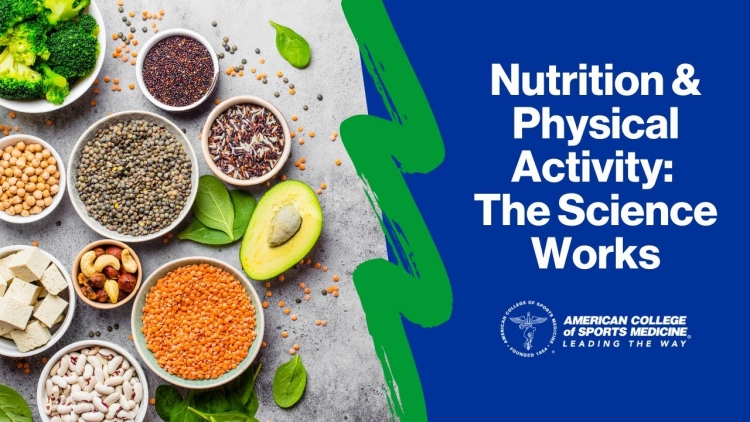Dan Benardot, Ph.D., DHC, R.D., L.D., FACSM |
Nov.
26, 2020

3 Nutrition FAQs from the webinar - Nutrition and Physical Activity: The Science Works
Watch the Webinar on the Professional Resources Page
Not a Member? Join Today!
Q1: How long in advance should an athlete start adapting or practicing nutrition/hydration that are needed for competition?
This is an important question that has no fixed answer. Importantly, ‘adaptation’ and ‘practice’ should be considered two distinct factors that ideally merge to result in the athlete competing at their top conditioned capacity. The length of time for adaptation varied depending on how different the competition environment is from the athlete’s current training environment. The greater the difference, the greater the amount of time necessary for appropriate adaptations to occur.
For instance, it is well established that it takes approximately 1 day of adaptation for every time zone crossed. So, an athlete living in California who is competing in London. The 8-hour time zone difference would require that the athlete have a minimum of 8 days to adapt their circadian rhythms so that they reach a state of normalcy in the new environment. The same issues arise for changes in accustomed altitude and/or temperature/humidity. The bigger the difference, the longer the adaptation time.
Practice/training nutrition issues are equally important to help assure that the athlete can perform at their best. There is no ‘advance’ time for this, as athletes should train with appropriate nutrition/hydration strategies in precisely the same way they would follow these strategies before, during, and after competition. This is a common problem with training, where we find athletes only following appropriate nutrition strategies in advance of competition.

Download your sample today
As an example, it is not uncommon for marathon runners to have their first run, often 8 to 10 miles, in the morning before breakfast and without a during-run hydration strategy. Ideally, they should always train in a way that mimics the competition reality to allow for optimal adaptation during the competition.
In this example, for instance, the runner should have something to eat/drink before the morning run to normalize blood sugar, and should drink a sports beverage every 5 km, to become accustomed to competition norms, where there is a hydration station every 5 km. Doing so has multiple benefits, not the least of which is helping the body adapt to this drinking frequency to avoid issues of gastric emptying, diarrhea, and vomiting. Importantly, practicing this strategy helps the athlete increase fluid volume without difficulty to better match fluid losses during the run. The result is a better maintenance of fluid volume, which improves stroke volume and sustains sweat rates, allowing the athlete to continue running faster without overheating.
In the best of all worlds, the athlete will follow appropriate nutrition strategies during practice, so that they can optimize what they do during competition. In addition, the athlete should allow ample time to adapt to different environments to allow circadian rhythms and other physiological factors (e.g., red blood cell concentration at high altitude) to achieve normalcy. Thank you for the question.

Q2: Can you speak on these restrictive diets that athletes do -- fasting overnight and then exercising for 3 hours and then eating?
This is an important issue, so I appreciate your question. The result of the strategy you describe is to create a state of relative energy deficiency, so it is important for you to carefully review the International Olympic Committee consensus statements on the health and performance issues created with Relative Energy Deficiency in Sport (RED-S). These references, as IOC consensus statements, are publicly available (suggest doing a Google Scholar search for ‘Mountjoy RED-S’) to download and review. Here are some references related to RED-S:
- Mountjoy M, Sundgot-Borgen JK, Burke LM, et al. IOC Consensus Statement on Relative Energy Deficiency in Sport (RED-S) Br J Sports Med. doi:10.1136/ bjsports-2018-099193
- Torstveit MK, Fahrenholtz I, Stenqvist TB, Sylta O, and Melin A. Within-Day Energy Deficiency and Metabolic Perturbation in Male Endurance Athletes. Int J Sport Nutr Exerc Metab. 2018; 28: 419-427
- Fahrenholtz IL, Sjödin A, Benardot D, et al. Within-Day Energy Deficiency and Reproductive Function in Female Endurance Athletes. Scand J Med Sci Sports 2018; 1-8: DOI: 10.111/sms.13030.
- Delk-Licata A, Behrens CE, Benardot D, et al. The Association Between Dietary Protein Intake Frequency, Amount, and State of Energy Balance on Body Composition in a Women’s Collegiate Soccer Team. Int J Sports Exerc Med 2019; 5(3):123. DOI:https://doi.org/10.23937/2469-5718/1510123
These papers and the book (ACSM’s Nutrition for Exercise Science) clearly describe the health and performance issues created when there is insufficient energy available to perform the physical task at hand. While there may be a temporary ‘weight’ loss, the elevation in cortisol suggests that far too much of the weight is coming from lean tissue, which compromises the very tissue the athlete is trying to improve through exercise.
In addition, cortisol is highly catabolic to bone tissue, placing the athlete at higher risk of skeletal injury (stress fracture, etc.). It is important to consider that blood sugar maintenance during the day with normal daytime activity is approximately 3 hours, and at night while asleep approximately 7 hours. Exercising when in a low blood sugar state, as these papers clearly describe, creates precisely the opposite outcomes to what the athlete is wishing to achieve. Thank you for asking this important question.
Q3: How long is glycogen synthase at its peak?
This is a critically important question, particularly for athletes involved in multiple competitions to determine who competes in the final, and for athletes involved in daily training. It has been determined that the highest rate of muscle glycogen synthesis occurs when large amounts of carbohydrate (1.0–1.85 g/kg/h) are consumed immediately post-exercise and at 15-minute intervals thereafter, for up to 5 hours post-exercise.
When the ingestion of carbohydrate is delayed by several hours, this may lead to approximately 50% lower rates of muscle glycogen synthesis. These findings suggest that glycogen synthase is at its peak when muscle glycogen is at its lowest: Immediately post-exercise. It begins its descent almost immediately after this point, with the baseline level being achieved 5-hours post-exercise.
These findings suggest that athletes should have a source of carbohydrate available to consume as they walk off the training venue so there is no consumption delay. Waiting to consume carbohydrate, however, is all too common with consumption often occurring after showering, dressing, and going home. Here’s a reference you may find useful:
- Jentjens R and Jeukendrup AE. Determinants of Post-exercise Glycogen Synthesis During Short-Term Recovery. Sports Medicine 33: 117-144.
Thank you for asking this important question.
Explore More Popular Nutrition Content

Nutrient Timing Strategy for Protein and More | Video

Nutrition Spotlight | CEC Bundle
Presenter:
ACSM Fellow Dan Benardot, Ph.D., DHC, R.D., L.D., is Professor Emeritus at Georgia State University, and Professor of Practice in the Center for the Study of Human Health at Emory University. He is the author of the popular book ACSM’s Nutrition for Exercise Science.